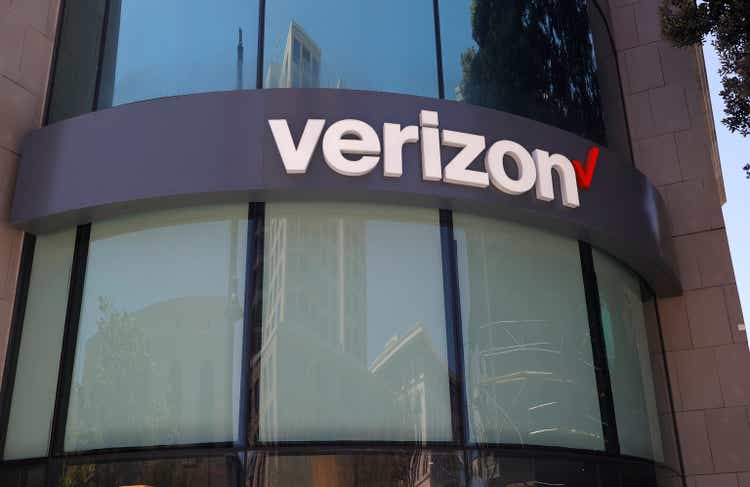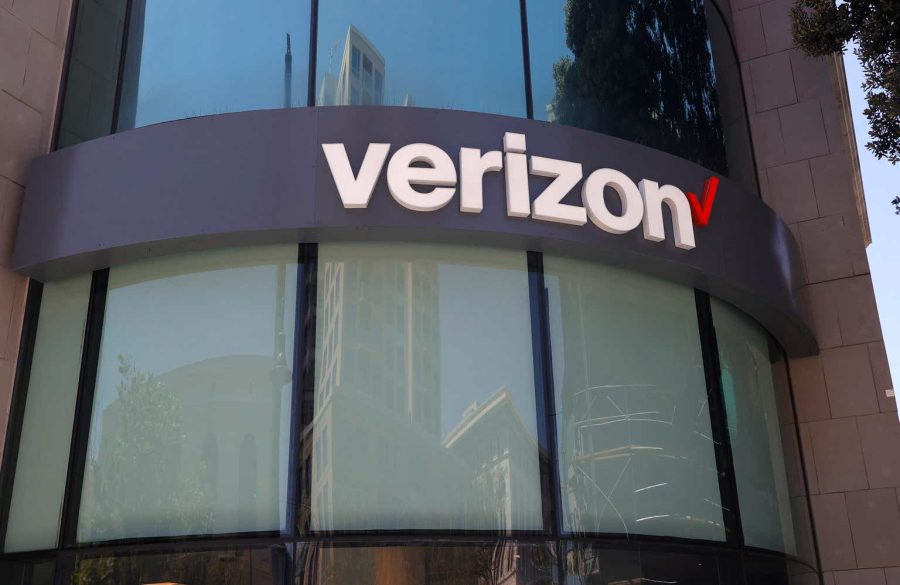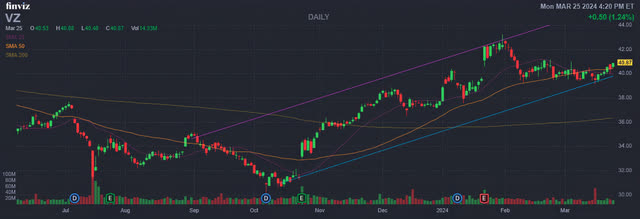Summary:
- Verizon stock has rebounded from 52-week lows and has future upside potential.
- The stock’s correlation with the Fed Funds Rate suggests it could rise as interest rates drop.
- Earnings estimates show some growth, and paying down debt could create long-term value for shareholders.
Justin Sullivan
Verizon Communications (NYSE:VZ) is a U.S. based communications company and a giant in the industry. A few months ago, this stock was making 52-week lows and trading at what seemed to be highly irrational levels. The selling pressure seemed to be a culmination of events that took place late last year, which included tax-loss selling, fears over liabilities from lead cables, as well as concerns over a significant debt load. The company is being sued for lead based cables and it still has a significant debt load, but the stock has rebounded from the lows it reached and it appears to have plenty of future upside.
In 2013, I wrote about Verizon and thought it was time to sell the stock. At that time the shares were trading for around $50 and at 18 times earnings, I felt the stock was overvalued. But things have changed. In terms of share price, the stock now trades for less than it did nearly 11 years ago, but more importantly, the price to earnings multiple is now almost half of what it was when I last wrote about this stock.
The Chart
The chart below goes back to around 2012, so it provides a very long-term view. What I think is notable is that the 200-week simple moving average (represented by the brown trendline) is currently around $45, and the stock is below that level now. From 2013 up until 2022, this stock only traded below the 200-week simple moving average once, which was in 2015. This shows how rare it is for this stock to trade below that major support level and yet it is below it now. This could be an anomaly, or it could be a sign that something has fundamentally changed with the valuation. I think it is both an anomaly and there has been something that has changed the valuation.
The fact is that the plunge that started in 2022, and continued until recently, occurred exactly at the same time that the Fed started raising rates. The first interest rate increase of this tightening cycle took place in March 2022. It’s no coincidence that higher interest rates took a toll on Verizon and other dividend stocks, and it is also notable that this stock started to rebound right when the Fed indicated in November 2023, that there would probably be no additional rate hikes. I think all of this shows a strong correlation between Verizon shares and the Fed Funds Rate.
Earnings Estimates And The Balance Sheet
Analysts expect Verizon to earn $4.60 per share in 2024, on revenues of nearly $136 billion. For 2025, the company is expected to earn $4.72 per share, with revenues coming in at $137.64 billion. In 2026, earnings estimates are at nearly $5 per share, on revenues of $139.46 billion. Verizon is clearly not a fast-growing company, but this shows there is some growth, especially when it comes to earnings per share. This is important because it could allow the company to raise the dividend and hopefully pay down some debt.
As for the balance sheet, Verizon has about $178.6 billion in debt and just over $2 billion in cash. This debt load is concerning and the company should address it by paying it down to more healthy levels. I believe paying down debt would create value for shareholders in the long term because a company with a strong balance sheet typically gets rewarded with a higher valuation.
The Dividend
Verizon pays a quarterly dividend of 66.5 cents per share which totals $2.66 per share on an annual basis. This dividend generates a yield of about 6.6%. Ten years ago, (in 2014) the quarterly dividend was 53 cents per share, so it has been rising, albeit slowly. In recent years, Verizon has been announcing dividend increases in July, so we might see another increase announced around that time this year. The next quarterly dividend is coming up soon. Shareholders of record as of April 10, 2024, will be paid the quarterly dividend on May 1, 2024.
Why Verizon Shares Could Surge When The Fed Cuts Rates
As could be seen on the chart above, Verizon shares plunged when interest rates jumped and have since started to rebound, just around the same time the Fed said it was probably done raising rates. I think this shows significant correlation with interest rates for Verizon. It also just makes sense that investors would be willing to pay more for Verizon’s dividend yield when rates are lower, and the inverse is also true. So, Verizon shares could rise as rates drop. In addition, lower rates could also reduce interest expenses for this company, especially since the debt load is very significant. This is another factor that could help boost earnings as well as the share price.
My Buying Strategy And Price Target
I currently own a small position in Verizon, but I plan to add to it on weakness. In terms of buying opportunities, pullbacks below $40 per share look even more attractive.
The Federal Reserve recently released projections for a 2.25 point drop in the Fed Funds rate by the end of 2026. This would indicate the Fed funds target rate dropping from the current range of 5.25% to 5.5%, to a range of 3% to 3.25%, by the end of 2026. Verizon currently yields a bit more than 1% over the current Fed Funds Rate. If this relationship with interest rate holds, Verizon could yield just a bit over 1% more than what the Fed Funds Rate is expected to be in 2026. That would put the yield on Verizon down to around 4.5%. For Verizon to yield 4.5% while paying a dividend that totals $2.66 per share annually, the stock would be trading for about $60 per share, therefore, that is my price target for this stock. A $60 price level for this stock represents a potential gain of 50%, plus shareholders collect a great dividend while waiting for this higher share price.
Potential Downside Risks
The multiple lawsuits over lead cable liabilities could continue for years. It is hard to say what the cost will be, but some estimates are out that suggest Verizon could face about $4.1 billion in liabilities. While this is a lot of money, it won’t move the needle much for Verizon. But, this issue could create headline risks for the stock. The debt load this company carries is very large and it is a potential downside risk, especially if revenues were to start declining.
In Summary
Verizon’s yield looks too generous to pass up on and the stock appears very undervalued. This stock shows signs of doing the inverse of rates, and with rates expected to decline for the next couple of years, it makes sense to buy now. My $60 price target implies a gain of 50%, plus there is a generous dividend.
No guarantees or representations are made. Hawkinvest is not a registered investment advisor and does not provide specific investment advice. The information is for informational purposes only. You should always consult a financial advisor.
Analyst’s Disclosure: I/we have a beneficial long position in the shares of VZ either through stock ownership, options, or other derivatives. I wrote this article myself, and it expresses my own opinions. I am not receiving compensation for it (other than from Seeking Alpha). I have no business relationship with any company whose stock is mentioned in this article.
Seeking Alpha’s Disclosure: Past performance is no guarantee of future results. No recommendation or advice is being given as to whether any investment is suitable for a particular investor. Any views or opinions expressed above may not reflect those of Seeking Alpha as a whole. Seeking Alpha is not a licensed securities dealer, broker or US investment adviser or investment bank. Our analysts are third party authors that include both professional investors and individual investors who may not be licensed or certified by any institute or regulatory body.

